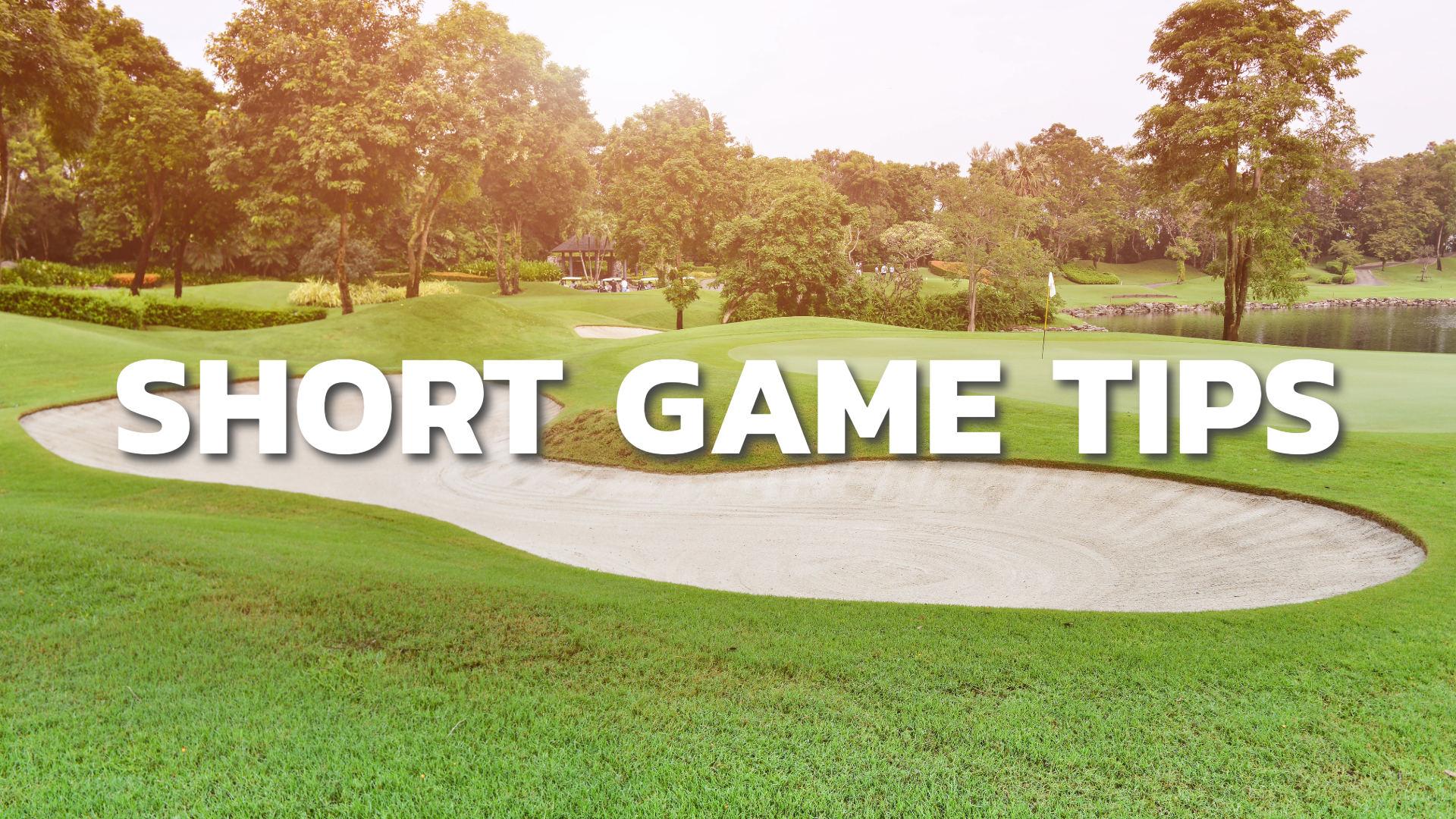
Improving your short game is the fastest way to shoot lower scores.
Because no matter how good you get, missing greens is a part of golf. This means you need to learn how to scramble around the greens and prevent wasted shots from close range.
This is especially important for beginner golfers who need some guidance on how to best improve their short game. Today we’ll dive into seven proven golf for beginner’s strategies to improve your short game and save shots like Seve Ballesteros around the green.
7 Proven Strategies to Improve Your Short Game
First off, what is the short game? Is it shots inside 50 to 100 yards? Or, just around the greens?
We think of the short game as anything inside 50 yards and doesn’t require a full swing. This includes partial wedges, chips, pitches, flops, bunker shots, and putting.
1. Play High Percentage Shots
The first tip is to keep things simple around the greens and play high-percentage shots (we’ll get into some examples of these next). Most amateur golfers try to hit a lot of high, lofted shots which might look cool in theory but are hard to execute consistently.
When you miss the green there are a few options – putt, chip, pitch, or hit a flop shot. Each shot works better for certain situations and lies.
- Putting from the fringe: If you have a good lie from the fringe, always try to putt before grabbing a wedge as it’s a very high percentage shot. You don’t need to change anything with your setup, just hit the putt harder as the fringe is longer grass. If you mishit the putt you’ll also end up much closer to the hole than a missed chip or pitch.
- Chipping: If you can’t putt it, a chip is the next best option as it’s a pretty simple shot to execute and a high-percentage play. Grab a wedge or short iron to flight it low and get it rolling like a putt once it’s on the green.
- Pitching: If you don’t have much green to work with or a bad lie, pitching is typically the best option. This is where you use a sand or lob wedge to hit a higher shot that doesn’t roll out as much as a chip shot.
- Flop shots: Finally, flop shots should act more as a last resort if you have a terrible lie or are very short-sided. Grab your lob wedge, add some speed, and make sure the lie is right for the shot.
The lower you keep the ball around the green, the more likely you are to hit it close and minimize your mishits. The higher you hit the ball, the more room for error.
The sooner you master your short game, the sooner you can reap rewards for the rest of your golf career.
2. Adjust Your Setup
To hit different chips and pitches you’ll want to make a few adjustments before you swing the club.
- Get more weight on your lead leg. By getting 60 or 65% of your weight on your front leg it makes it easier to hit down on the shot for ball first contact. Otherwise, you might leave your weight back and skull it over the green.
- Narrower stance. For basic chips and pitches you don’t have a big stance (bunkers are a different story, more on that below). A narrower stance helps get your weight more toward the target to hit a crisp chip shot.
- Choke up. For almost all shots around the green choke up 1–2 inches for more control. Choking up also makes it easier to accelerate and create speed for better contact. Otherwise, it’s easy to decelerate and hit a lot of fat chip shots.
3. Learn How to Read Greens
One of the most important short game tips is to learn how to read greens. When you’re confident on the break of the putt, it makes it much easier to stand over the ball with confidence.
Here are two easy ways to simplify green reading:
- Go with your gut instinct. When you mark your ball and read the putt from behind, trust your initial read. If you think it’s a downhill left to right putt that starts just outside the left edge and rolls in the middle of the hole, trust it. Too many golfers try to read the putt from multiple angles and only confuse themselves on the break.
- Use reverse visualization. As you’re reading the putt, always ask yourself this one question, “Where is the ball going in the hole?” This question tricks your mind in two ways – first it implies you’re going to make the putt which will give you more confidence standing over it. Second, it forces your mind to imagine the ball going in the hole at a specific part of the hole with a certain amount of speed.
Regardless of how you choose to read greens, make sure you commit to a read before you get into your routine. This will help you stand over the putt with confidence and increase the likelihood of hitting a good putt.
4. Understand Bunker Fundamentals
Bunkers terrify most everyday golfers yet the pros make these shots look easy. So what do pros do differently than amateurs?
Get into a proper setup position. A few tweaks to your setup will make a huge difference in getting it out of the bunker in one shot.
A weaker grip makes it easy to keep the clubface open so the ball can clear the bunker lip and land softly on the green. The next adjustment is to add more knee bend for extra stability which makes it easier to lower the handle of the golf club, adds loft, and lets you use the bounce of the club.
Next, get your sternum pointed behind the golf ball – this will make it easy to hit the sand, then the golf ball. You’ll also want more weight on your lead leg to avoid a swaying movement which leads to a lot of thin and fat bunker shots.
Finally, make sure to swing with speed. Most golfers don’t have enough speed and decelerate which leads to leaving shots in the bunker. Don’t forget, sand is heavy so you need plenty of speed to get through it!

5. Speed Up Your Tempo
Tempo is another important part of golf, and they differ for both short game and long game.
Long game tempo is 3 to 1 – which means the backswing takes three times as long as the downswing. However, after studying some of the best short game players including Tiger Woods, Phil Mickelson, and countless others, the authors found shorter shots require a faster tempo.
By speeding up your tempo you’ll be able to get yourself out of bad lies easier, make better contact, create more spin, and hit more consistent short game shots. Test out your tempo in practice with a metronome app on your phone to see how it impacts your quality of shots.
6. Practice Your Short Game More Often
To improve your short game fast, spend more time on it during practice sessions. If you go to the driving range or practice area at almost any golf course you’ll notice the majority of players banging balls not at the short game area.
But if you think about the average round of golf, a majority of shots happen from inside 50 yards. Which is why you need to practice from this range more often.
Think of short game practice like investing in boring index funds that pay dividends for years to come. The sooner you master your short game, the sooner you can reap rewards for the rest of your golf career.
Here are a few short game practice tips:
- Always putt before the driving range. By going to the putting green first you don’t neglect arguably the most important part of the game.
- Spend 70% of your time on 3 to 6 footers. This is the easiest way to gain shots every round.
- Practice shots that scare you. Whether it’s the bunker, chipping from hardpan, or high flops. Make practice difficult so you’re prepared for anything on the golf course.
Check out our golf for beginners practice guide for more tips and tricks to improve your game.
7. Develop a Short Game Routine
For lower scores, it’s important to develop a consistent short game routine. If you watch the best golfers in the world you’ll notice they have three routines; full swing routine, short game routine, and putting routine.
Yet, most amateur golfers have no routine for their short game (chipping/pitching) or putting. Routines help your mental game, analyze the shot, and pick the right target.
As Tiger Woods said in his book, How I Play Golf, “The thing about my routine is I never change it. I do it at the same speed and go through the same thought process every single time.
Not only do I gather all the information I need about the putt itself, I also get myself in the best frame of mind to stroke the putt.”
Put These Tips to the Test
Use these short game golf tips to start dropping shots fast. The full swing is always a work in progress but your short game is the key to lower scores and more satisfying rounds.
As we wrap up this journey to improve your short game, remember that progress takes time and practice. The tips and techniques we’ve explored are your toolkit for success, but it’s up to you to take them to the short game practice area.
Embrace the challenge, enjoy the process, and watch as your confidence soars even from tricky situations around the greens.
Want even more expert advice to improve your golf game? Make sure to check out Scratch Club which is an all access pass to dial in the six most important areas of the game.

